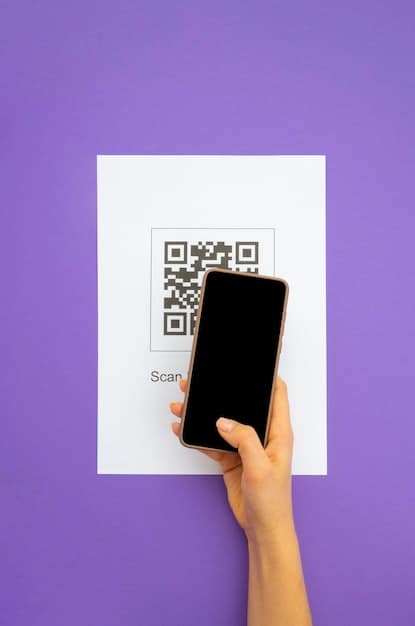Digital Payment Security Alert: New Fraud Tactics in 2025 & How to Protect Yourself

Digital Payment Security Alert: In January 2025, US consumers face three new sophisticated fraud tactics targeting digital payments, including AI-driven phishing, QR code scams, and malware-embedded payment apps, demanding immediate awareness and proactive protective measures.
The digital payment landscape is constantly evolving, and so are the tactics of fraudsters. As we move into January 2025, US consumers need to be aware of the latest threats to their financial security. A **digital payment security alert** has been issued, highlighting three new fraud tactics that are specifically targeting individuals using digital payment methods. Staying informed is the first line of defense against these scams, and this article will equip you with the knowledge to protect yourself.
New Digital Payment Fraud Tactics Emerging in 2025
The start of 2025 brings not only new opportunities but also new challenges in the realm of digital payment security. Fraudsters are becoming increasingly sophisticated in their methods, making it crucial for consumers to stay one step ahead. Understanding these emerging tactics is the first step in safeguarding your financial information and digital assets.
AI-Driven Phishing Attacks
One of the most significant threats is the rise of AI-driven phishing attacks. These attacks use artificial intelligence to create highly personalized and convincing scams. Fraudsters can analyze your social media profiles, online activity, and even leaked data to craft phishing emails or messages that appear legitimate.
QR Code Scams
QR codes have become ubiquitous, offering a convenient way to access information or make payments. However, this convenience also makes them a prime target for scammers. Malicious QR codes can redirect users to fake websites, initiate unauthorized payments, or install malware on their devices.
- Verify the Source: Always ensure the QR code comes from a trusted source.
- Check the URL: Before entering any information, carefully examine the URL after scanning the code.
- Use QR Code Scanners with Security Features: Some scanners offer built-in security features to detect malicious codes.

These new tactics pose a significant risk to US consumers, highlighting the need for constant vigilance and proactive security measures. By understanding how these scams work, you can better protect yourself from becoming a victim of digital payment fraud.
Protecting Yourself from AI-Driven Phishing Scams
AI-driven phishing scams are particularly insidious because of their ability to mimic legitimate communications. These sophisticated attacks can be difficult to spot, even for experienced internet users. However, there are several strategies you can employ to protect yourself.
Recognizing the Red Flags
The first step is to learn how to recognize the red flags of a phishing scam. Look for inconsistencies in email addresses, grammar errors, and urgent requests for personal information.
Verifying Sender Identity
Always verify the sender’s identity before responding to any email or message. Contact the organization directly through a known phone number or website to confirm the legitimacy of the communication.
- Enable Multi-Factor Authentication (MFA): MFA adds an extra layer of security to your accounts.
- Use Strong, Unique Passwords: Avoid using the same password for multiple accounts.
- Keep Software Updated: Regularly update your operating system, web browser, and security software.
With awareness and caution, you can minimize your risk of falling victim to AI-driven phishing scams and safeguard your personal and financial information.
Avoiding QR Code Payment Traps
QR codes offer a fast and easy way to make payments, but their convenience also makes them attractive to fraudsters. It’s important to exercise caution when scanning QR codes to avoid falling victim to scams.
Understanding the Risks
The primary risk is that a QR code can redirect you to a fake website or initiate an unauthorized payment. Scammers often replace legitimate QR codes with malicious ones in public places or send them via phishing emails.
Best Practices for Scanning QR Codes
Before scanning a QR code, take a moment to assess its surroundings and source. Be wary of QR codes placed in unusual locations or received from unknown senders.

- Use a Reputable QR Code Scanner: Some scanners offer security features that can detect malicious codes.
- Preview the URL: Most QR code scanners display a preview of the URL before redirecting you. Check it carefully for any signs of fraud.
- Never Enter Sensitive Information: If a website asks for your credit card number, social security number, or other sensitive information, proceed with caution.
By following these best practices, you can use QR codes safely and avoid falling victim to scams. Always prioritize your security and be wary of unknown or suspicious QR codes.
Identifying and Preventing Malware-Embedded Payment Apps
Malware-embedded payment apps pose a significant risk to your financial security. These apps may appear legitimate, but they contain malicious software that can steal your personal and financial information.
Recognizing Fake Apps
Fake apps often mimic the appearance of legitimate ones, but they may have subtle differences in their name, logo, or description. Pay close attention to these details before downloading any app.
Downloading Apps Safely
Only download apps from trusted sources, such as the official app stores (e.g., Apple App Store, Google Play Store). Be wary of downloading apps from third-party websites or unknown sources.
- Read Reviews: Before downloading an app, read reviews from other users to see if they have reported any problems.
- Check Permissions: Review the permissions an app requests before downloading it. Be wary of apps that ask for permissions that are not relevant to their functionality.
- Use Anti-Malware Software: Install anti-malware software on your mobile device to detect and remove malicious apps.
By following these precautions, you can reduce your risk of downloading malware-embedded payment apps and protect your financial information from theft.
Staying Updated on the Latest Digital Payment Threats
The landscape of digital payment fraud is constantly evolving, with new tactics and scams emerging all the time. It’s important to stay informed about the latest threats and security best practices.
Following Security News and Alerts
Subscribe to security news and alerts from reputable sources, such as the Federal Trade Commission (FTC) and the Better Business Bureau (BBB). These organizations often publish alerts about new scams and provide tips on how to protect yourself.
Attending Security Awareness Training
Consider attending security awareness training sessions to learn about the latest digital payment threats and how to avoid them. Many organizations offer free or low-cost training programs for consumers.
- Regularly Review Account Statements: Check your bank and credit card statements regularly for any unauthorized transactions.
- Monitor Your Credit Report: Order a free copy of your credit report from each of the three major credit bureaus (Equifax, Experian, and TransUnion) and review it for any errors or fraudulent activity.
- Report Suspicious Activity: If you suspect you have been a victim of digital payment fraud, report it to your financial institution and the FTC immediately.
By staying informed and proactive, you can better protect yourself from digital payment fraud and minimize your risk of financial loss.
Implementing Strong Security Measures for Your Digital Wallets
Digital wallets offer a convenient way to store and use your payment information, but they also require strong security measures to protect against fraud. Implementing these measures can significantly reduce your risk of becoming a victim of digital payment scams.
Enabling Multi-Factor Authentication
Multi-factor authentication (MFA) adds an extra layer of security to your digital wallet. With MFA enabled, you’ll need to enter a code from your phone or email in addition to your password to access your wallet.
Using Strong Passwords
Use strong, unique passwords for your digital wallet and other online accounts. Avoid using the same password for multiple accounts, and choose passwords that are difficult to guess.
- Keep Your Software Updated: Regularly update the software on your mobile device and computer to patch security vulnerabilities.
- Use a Secure Network: Avoid using public Wi-Fi networks when making digital payments, as these networks are often unencrypted and vulnerable to hacking.
- Monitor Your Accounts Regularly: Check your digital wallet and bank accounts regularly for any unauthorized transactions.
By implementing these strong security measures, you can enhance the protection of your digital wallets and minimize your risk of digital payment fraud.
| Key Point | Brief Description |
|---|---|
| 🛡️ AI Phishing | Recognize & verify senders to avoid personalized AI phishing scams. |
| 🤳 QR Code Scams | Ensure QR codes are from trusted sources; preview URLs before interacting. |
| 📱 Malware Apps | Download apps only from official stores, check reviews, and use anti-malware. |
FAQ
▼
The new tactics include AI-driven phishing, where scammers use AI to create personalized and convincing scams. QR code scams involve malicious QR codes redirecting to fake sites, and malware-embedded payment apps steal personal and financial data.
▼
Look for inconsistencies in email addresses, grammar errors, and urgent requests for personal information. Always verify the sender’s identity by contacting the organization directly through a known phone number or website.
▼
Ensure the QR code comes from a trusted source and preview the URL before proceeding. Use QR code scanners with security features and never enter sensitive information on unfamiliar websites.
▼
Only download apps from official app stores and check the app’s reviews and permissions before downloading. Install anti-malware software on your device and be wary of apps from unknown sources.
▼
Report the incident immediately to your financial institution and the Federal Trade Commission (FTC). Monitor your accounts for any unauthorized transactions and consider placing a fraud alert on your credit report.
Conclusion
In conclusion, staying vigilant and informed about the latest digital payment fraud tactics is crucial for protecting yourself in 2025. By understanding the risks and implementing the preventative measures outlined above, you can navigate the digital payment landscape with greater confidence and security. Remember, being proactive is your best defense against these ever-evolving threats.





